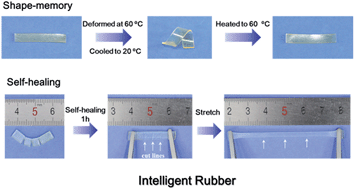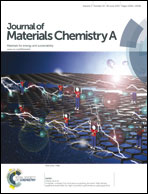Intelligent rubber with tailored properties for self-healing and shape memory†
Abstract
A strategy for combining covalent and non-covalent cross-links to construct multifunctional rubber materials with intelligent self-healing and shape memory ability is demonstrated. Rubbers were prepared by self-assembly of complementary polybutadiene oligomers bearing carboxylic acid and amine groups through reversible ionic hydrogen bonds via the acid–base reaction, and then further covalently cross-linked by tri-functional thiol via the thiol-ene reaction. The resulting polymers exhibit self-healing and shape memory functions owing to the reversible ionic hydrogen bonds. The covalent cross-linking density can be tuned to achieve tailorable mechanical and stimuli-responsive properties: a low covalent cross-linking density maintains the remarkable self-healing capability of rubber at ambient temperature without any external stimulus, while a high covalent cross-linking density improves the mechanical strength and induces shape memory behavior, but effective self-healing needs to be triggered at high temperature. This strategy might open a promising pathway to fabricate intelligent multifunctional polymers with versatile functions.


 Please wait while we load your content...
Please wait while we load your content...